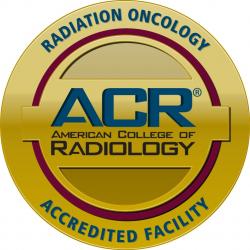Radiation oncology in San Jose, California
Good Samaritan Hospital is a recognized leader in Bay Area communities for radiation oncology treatment. This is, in part, because our hospital uses the latest radiation technology to precisely target and treat cancer while sparing as much healthy tissue as possible. We have used these advanced methods of radiation therapy to treat thousands of patients, including many who have traveled long distances for access to our high-quality care.
To learn more about radiation therapy for cancer treatment, please call askSARAH at (844) 482-4812.
Recognition

Good Samaritan Hospital is accredited by the American College of Radiology for excellence in radiation oncology services.
Types of radiation therapy
Radiation therapy is a type of cancer treatment that uses high-energy waves to kill cancer cells and shrink tumors. The radiation therapies we may use to treat you depend on the location of the tumor and the type of cancer.
We offer the following radiation therapy procedures:
- 3D high-dose rate (HDR) brachytherapy — This form of radiation therapy uses a radioactive seed that is placed inside a catheter. The catheter is directed within or adjacent to the tumor tissue. It is used to perform partial breast irradiation, a five-day targeted therapy for breast cancer, and is used to treat gynecologic cancers.
- Intensity-modulated radiation therapy (IMRT) — This radiation treatment uses external beam radiotherapy to deliver more precisely targeted radiation beams to tumors. It also spares surrounding healthy organs and tissues.
- Image-guided radiotherapy (IGRT) — This treatment uses image guidance, such as X-ray or computerized tomography (CT) scans, to verify a tumor's location before radiation therapy. It is often used in combination with IMRT for extreme precision and a faster treatment time.
- Robotic radiosurgery — This is a non-invasive procedure that uses advanced technology to deliver radiation treatment to tumors anywhere in the body with pinpoint accuracy.
- Stereotactic radiosurgery — This radiation treatment is used to destroy a targeted tumor. It uses an external beam radiation source to deliver small beams directly to the target site. It does not affect any adjacent structures in the body.
Side effects of radiation therapy
Radiation therapy is not painful and does not cause hair loss (except when applied somewhere that grows hair, such as the scalp). The most common side effects are fatigue and skin changes. However, every patient reacts differently to radiation therapy, and symptoms will depend on the site receiving treatment.
Advantages of radiation therapy
Radiation oncology offers many benefits over other types of cancer treatments, including:
- It can be used in any part of the body
- It is a localized treatment, which helps patients who cannot be treated through surgery or chemotherapy alone
- It can reduce the size of a tumor so it can be removed surgically
Radiation therapy treatment
Patients often have many questions before beginning radiation therapy. Our teams are here to help you understand everything you want to know. We have also outlined general information about our radiation treatments below, so patients can have a better idea of what to expect:
- You can expect to receive treatment for 15 to 20 minutes at a time, although additional time may be needed due to repositioning.
- Radiation therapy is not painful, although some patients with pre-existing conditions, such as back pain, may experience physical discomfort from lying in a certain position on the therapy table.
- Most patients are able to continue working and driving throughout the course of their treatment.
- Radiation therapy does not cause hair loss unless it is targeted on an area of the body that grows hair, such as the scalp.
- There are no dangers or restrictions on being around other people, such as family and children, during treatment.
- Patients undergo treatment every weekday, typically for five to nine weeks.
Preparing for radiation treatment
Before radiation treatment begins, our patients attend an initial consultation with our radiation oncologist. Before this consultation, patients should prepare a list of questions and consider bringing along a support person. This first meeting takes about an hour and a half. A nurse will check the patient's vitals signs and review their paperwork.
The doctor will examine the affected area and plan for a CT simulation to be done prior to beginning therapy. CT simulation uses X-rays to create a visual display of a tumor. This is beneficial when a patient is receiving targeted treatments and helps to spare surrounding healthy tissue.
Radiation therapy typically begins 1 ½ to two weeks after the initial consultation and CT simulation. This allows ample time for treatment planning. The day before treatment begins, additional X-rays will be taken to ensure everything is aligned for treatment.
Where to go for radiation therapy
Our outpatient radiation services are offered on our Mission Oaks campus in the Mission Oaks Medical Plaza.
About Sarah Cannon Cancer Institute
As part of Sarah Cannon, the Cancer Institute of HCA Healthcare, our hospital provides comprehensive cancer services with convenient access to cutting-edge therapies for people facing cancer in our community. From diagnosis to treatment and survivorship care, our oncology expertise ensures you have access to locally trusted care with the support of a globally recognized network.
askSARAH helpline
Have cancer questions? We can help. askSARAH is a dedicated helpline for your cancer-related questions. Our specially trained nurses are available 24/7, and all calls are confidential. Contact askSARAH at (844) 482-4812.

